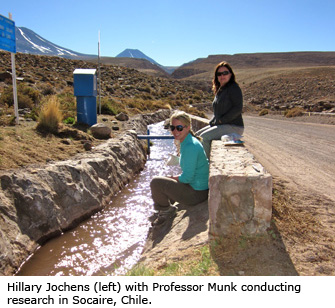Student and professor team up to study sources and geochemical processes of lithium deposits
by Kathleen McCoy |
Lithium ion batteries are something most people are familiar with if they have a smartphone in their pocket or a computer on their lap. But did you know that the metallic element is also a candidate as a new energy source for the next generation of vehicle power?
Lithium has been identified by the U.S. Department of Energy as having the greatest potential in battery propulsion of hybrid and electric vehicles, and they have looked now to the U.S. Geological Society (USGS) to discover the intricacies of lithium production to support these future goals of putting lithium ion batteries on the road. In turn, the USGS has funded a $70K grant for UAA geology professor LeeAnn Munk's research "Lithium Brine Resources: A Predictive Exploration Model."

For the past year, Munk has engaged UAA geology student Hillary Jochens for a portion of her larger project. Specifically, Jochen's undergraduate research ("Identifying Lithium Sources and Geochemical Processes that Concentrate this Scarce and Technologically Important Element") focused on the effects of ambient temperature weathering on the release of lithium and its contribution to a specific continental brine deposit in Clayton Valley, Nev. And while she is beginning to answer some of the questions she started with, the process has uncovered even more questions.
"I do have a lot of results from this thesis, but I think what we found is that without more specific work, especially with isotopes, we can only make assumptions," says Jochens. "I have a lot of great hypotheses about why lithium is released from this rock and not that rock, and what contribution this low temperature weathering has to these deposits-but at this stage, the results are still very preliminary."
Jochens plans to continue her lithium research with Munk as a graduate student at UAA next fall as well as continuing as Munk's part-time research lab assistant. Her undergraduate research was made possible in part by a $6,500 Fran Ulmer Transformative Research Award from the University Honors College as well as Munk's larger USGS grant.
Munk's overarching study focuses on lithium deposits in both Clayton Valley as well as Chile. "So my portion was this low temperature weathering part of specifically Clayton Valley," says Jochens. "It's a small basin compared to the one in Chile, but a nice model potentially for everything else." And while Jochens has been focusing on rocks, Munk's study also includes geothermal and meteoric water sources.
So the question remains: Are lithium deposits prevalent and renewable enough, and can a lithium production model be supported sustainably, that it makes sense to start tapping this important resource? Munk and Jochens are still hard at work to help answer that question.
For more information: Hillary's research proposal for the Fran Ulmer Transformative Research Award (PDF).
 "Student and professor team up to study sources and geochemical processes of lithium
deposits" is licensed under a Creative Commons Attribution-NonCommercial 4.0 International License.
"Student and professor team up to study sources and geochemical processes of lithium
deposits" is licensed under a Creative Commons Attribution-NonCommercial 4.0 International License.









